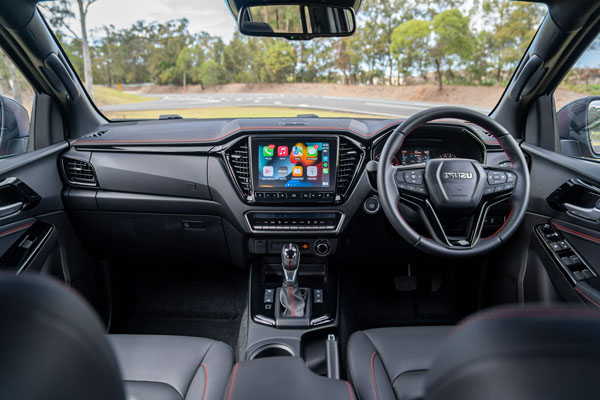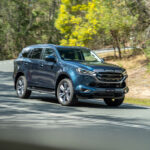
It seems that like the Genie of the Lamp a customer’s wish is Isuzu Ute’s command, for
a new model has elbowed its way into the top echelons of its rugged pick-up truck
ranks.
The Japanese manufacturer has slotted the D-Max LS-U+ in between the well-
presented LS-U double cab lifestyle ute and flagship of the updated third generation
for those who want a touch of luxury without the ‘shouty’ styling of the X-Terrain.
The new D-Max LS-U+ Crew Cab 4×4 Ute features similar equipment to the MY22 LS-
U variant, but with the addition of premium black leather-accented upholstery and
interior trims.
Convenience is also enhanced by the addition of a Smart Key, providing keyless entry,
push button start, welcome light, and walk away door lock. Similar to the system in
the X-Terrain, the welcome light illuminates the cabin when it detects the key is within 2
metres of the vehicle and the latter automatically locks the vehicle when the smart key
is detected more than 3m away.
Also available is a genuine canopy, which adds a combination of convenient lockable
pop-out or sliding windows, making the LS-U+ a versatile load carrier.
Pricing reflects the added creature comforts and convenience, with the LS-U+ priced
at $61,900 plus on-road costs, $2500 more than the regular LS-U, but considerably
$4000 cheaper than the range-topping X-Terrain.
Warranty is six years or 150,000 kilometres; seven years roadside assistance, provided
servicing is with an Isuzu Ute dealer, and seven years capped price servicing.

STYLING
The LS-U+ comes exclusively with a double cab and style-side high tensile steel body
on a ladder-frame chassis.
The front is lifted from X-Terrain extremes with a dark coloured grille broken up by dual
chrome cross pieces, the latter considered a badge of premium quality, especially in
Europe.
Flanking this are automatic bi-LED headlights, incorporating LED daytime running
lights, with auto-levelling and automatic high beam control. Below are LED fog lights.
LEDs sign off the rear with combination taillights. On a sad note, large heated door
mirrors are poorly positioned up front to produce a niggling blind spot.
A versatile factory-fitted tub liner is installed inside the 1570 mm long, 1530 mm wide,
490 mm deep tray. A selection of tonneaus and canopies is available from the Isuzu
Ute Genuine Accessories catalogue. The test vehicle was fitted with a manually
operated lockable roller tonneau cover (see Summary below).
The D-Max LS-U+ rolls on 18 inch machined-face alloy wheels with 265/60R18
Bridgestone 684II HT tyres. There’s a full-size spare.
INTERIOR
The cabin is modern and comfortable, with black leather-accented upholstery, eight-
way power assisted driver’s seat with power lumbar support and a premium-leather
bound steering wheel with reach and rake adjustment.
Dual zone air-conditioning allows driver and front passenger singly to control the
temperature. Rear passengers also benefit from rear air vents.

INFOTAINMENT
High on the central dash is a 9-inch high-definition infotainment system, featuring voice
recognition, in-built satellite navigation, DAB+ radio, and the latest in smartphone
mirroring, with Android Auto and wireless Apple CarPlay. Occupants can take
advantage of a premium eight-speaker surround sound system
ENGINES / TRANSMISSIONS
The LS-U+ is powered by Isuzu’s 3.0-litre, turbo-diesel engine, developing 140 kW of
power and 450 Nm of torque, mated with a six-speed automatic transmission.
SAFETY
In line with all MY22 D-Max models, the LS-U+ takes up a five-star ANCAP safety
rating and comes standard with Isuzu’s Intelligent Driver Assistance System, a suite of
advanced driver safety and assistance technologies, including a state-of-the-art 3-D
stereo camera that detects other motorists, pedestrians and cyclists. .
Standard with IDAS are autonomous emergency braking with turn assist, adaptive
cruise control, traffic sign recognition, blind spot monitoring, rear cross-traffic alert, lane
keep assist, plus eight airbags including a knee and centre-airbag.
DRIVING
Sharing its engine and chassis with the Mazda BT-50, there is considerable clatter from
under the D-Max LSU+ bonnet. There’s little excuse these days for this amount of
diesel rattle and here the motor shows its age.
The six-speed transmission handles most situations but can be a tad tardy in dropping
down a cog under hard acceleration.
Isuzu claims a combined urban/ highway fuel consumption of 8.0 litres per 100
kilometres. The test LS-U+ used as much as 10 litres per 100 kilometres of diesel in
city working and 6.6 litres per 100 kilometres on motorway cruising, so there’s little to
complain about here.
I am not alone in having a love-hate relationship with vehicle lane intervention. As part
of the IDAS suite, the LS-U+ features the new Lane Support System switch, located on
the steering wheel, allowing the driver to toggle all Lane Support Systems on or off, by
a single push of the button for two seconds.
Going off road? Switch to Isuzu’s Terrain Command 4×4 with 2-High, 4-High and 4-Low
drive modes, an electromagnetic rear differential lock and ground clearance of 240 mm.
Measuring up among the best in the range, approach, departure and ramp-over angles
weigh in at 30.5 deg, 19.0 deg and 23.8 deg, respectively. A water wading depth of up
to 800 mm is also up there with the best in class.
With customer surveys detailing that close to half of all Isuzu owners tow with their
vehicle, the D-Max LS-U+ has a 3.5 tonne braked towing capacity and is equipped with
a factory-fitted tow bar receiver as standard.
Customers can thus tailor their vehicle to specific towing needs, with an optional seven
or 12 pin plug, electronic brake controller, tow tongue insert with 50 mm ball and a
weight distribution hitch. All are available through Isuzu Ute’s Genuine Accessories
catalogue.
SUMMARY
Isuzu’s third-generation D-Max range has successfully muscled in on the highly
competitive pick-up truck range in Australia with close to 22,000 examples sold in 2021.
Proving popular among families, however, it’s worth remembering tub capacity and
versatility are seriously limited by the solid roller cover – a bit like comparing a briefcase
to a travel trunk.
RATINGS
Looks: 8/10
Performance: 5/10
Safety: 7/10
Thirst: 4/10
Practicality: 7/10
Comfort: 7/10
Tech: 8/10
Value: 6/10
AT A GLANCE
MODEL LINE-UP
Isuzu D-Max Single Cab Chassis SX manual: $41,200
Isuzu D-Max Single Cab Chassis SX: $43,200
Isuzu D-Max Space Cab Chassis SX manual: $44,700
Isuzu D-Max Space Cab Chassis SX: $46,700
Isuzu D-Max Crew Cab Chassis SX manual: $47,700
Isuzu D-Max Crew Cab Chassis SX: $49,700
Isuzu D-Max Crew Cab Ute SX: $50,900
Isuzu D-Max Crew Cab Ute LS-M manual: $52,000
Isuzu D-Max Crew Cab Chassis LS-M: $52,800
Isuzu D-Max Crew Cab Ute LS-M: $54,000
Isuzu D-Max Space Cab Ute LS-U: $56,400
Isuzu D-Max Crew Cab Ute LS-U manual: $57,400
Isuzu D-Max Crew Cab Ute LS-U: $59,400
Isuzu D-Max Crew Cab Chassis LS-U: $58,200
Isuzu D-Max Crew Cab Ute LS-U+: $61,900
Isuzu D-Max Crew Cab Ute X-Terrain: $65,900 ($62,990 driveaway)
Note: These prices do not include government or dealer delivery charges. Contact your
local Isuzu dealer for drive-away prices.
SPECIFICATIONS (Isuzu LS-U+ 3.0L 4-cylinder turbodiesel, 6sp automatic, 4×4 Utility)
ENGINE:
Configuration: Four cylinders inline
Maximum Power: 140 kW @ 3600 rpm
Maximum Torque: 450 Nm @ 1600-2600 rpm
Fuel Type: Diesel
Combined Fuel Cycle (ADR 81/02): 8.0 L/100km
DRIVELINE: Six-speed electronically controlled automatic, 4×4
DIMENSIONS, WEIGHT AND CAPACITIES:
Length: 5270 mm
Wheelbase: 3125 mm
Width: 1870 mm
Height: 1790 mm
Turning Circle: 12.5 metres
Kerb Mass: 2112 kg
Fuel Tank Capacity: 76 litres
BRAKES:
Front: Ventilated disc
Rear: Drum
STANDARD WARRANTY:
Six years / 150,000 kilometres










